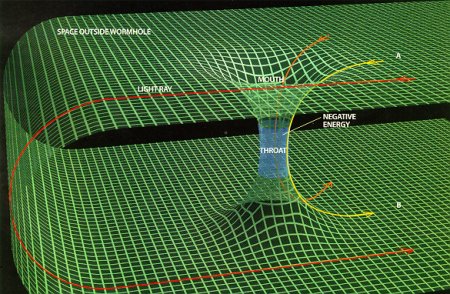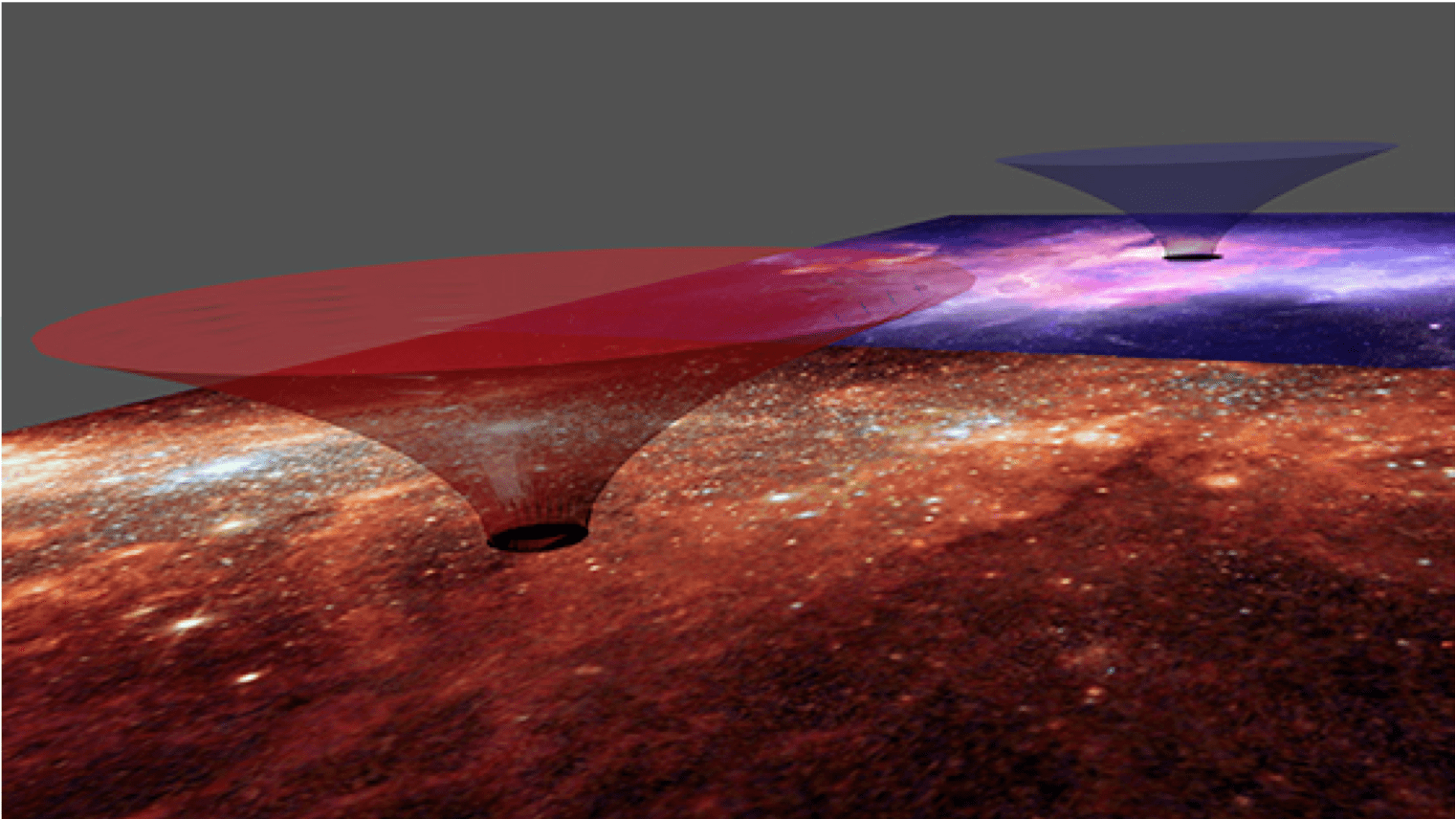Our very own Milky Way could be home to a giant tunnel in spacetime.
At least, that’s what the authors of a new study have proposed. According to the team, a collaboration between Indian, Italian, and North American researchers at the International School for Advanced Studies (SISSA) in Italy, the central halo of our galaxy may harbor enough dark matter to support the creation and sustenance of a “stable and navigable” shortcut to a distant region of spacetime – a phenomenon known as a wormhole.
Wormholes were first conceptualized by Albert Einstein and Nathan Rosen in 1935. Far from being fodder for science fiction, the two scientists instead proposed their idea as a way to get around the idea of black hole singularities. Rather than creating a knot of infinite density, Einstein and Rosen thought, the hefty energy inherent in such a massive body would distort spacetime to such an extent that it bent over on itself, allowing a bridge to form between two distant areas of the Universe. Alas, these wormholes would be extremely unstable and would require enormous amounts of “negative energy” to remain open.

But according to the team at SISSA, large amounts of dark matter could provide this fuel. Using a model of dark matter’s abundance that is based on the rotation curves of other spiral galaxies, the researchers found that the distribution of dark matter in the Milky Way produced solutions in general relativity that would, theoretically, allow a stable wormhole to arise.
Paulo Salucci, an astrophysicist on the the team from SISSA, explained: “If we combine the map of the dark matter in the Milky Way with the most recent Big Bang model to explain the universe and we hypothesise the existence of space-time tunnels, what we get is that our galaxy could really contain one of these tunnels, and that the tunnel could even be the size of the galaxy itself.” He continued, “But there’s more. We could even travel through this tunnel, since, based on our calculations, it could be navigable. Just like the one we’ve all seen in the recent film Interstellar.”
Of course, Salucci and the other researchers were working on this project long before Interstellar was released, but their result does lend some theoretical support to the ideas in the film – ideas that were also fact-tested and revised by physics guru Kip Thorne of Caltech.
The authors believe that their result reinforces the importance of discerning the true nature of dark matter. According to Salucci, “Dark matter may be ‘another dimension’, perhaps even a major galactic transport system. In any case, we really need to start asking ourselves what it is”.
It is important to understand that this is purely a mathematical result. Indeed, such a wormhole may be theroretically possible… but that doesn’t mean it’s probable. Salucci ventured, “Obviously we’re not claiming that our galaxy is definitely a wormhole, but simply that, according to theoretical models, this hypothesis is a possibility.”
The researchers went on to explain that their idea could be tested experimentally by comparing our own Milky Way, a spiral galaxy, with a nearby galaxy of a different type. By comparing the dark matter distributions between the two galaxies, scientists would potentially be able to use general relativity to probe differences in their spacetime dynamics.
Realistically, the technology that would allow researchers to do that is a long way off. But never fear, science (and scifi) fans – you can still check out the team’s wormhole simulation in the animation below, watch the movie if you haven’t already, and/or get your hands on a copy of Kip Thorne’s book, The Science of Interstellar.
The team’s research was published in the November 2014 issue of Annals of Physics. A pre-print of the paper is available here.


But how do we test wild ideas like this?
You don’t. That’s the beauty of this paper. There is no way to test it shy of going thru the worm hole (or at least sending a probe thru).
But too many people are leaving common sense and science behind.
In a wormhole, space-time has no meaning. Just because you go into a worm hole on April 20 2015, does not mean you get to roll back 1 billion years to a fiery Supernova explosion as it occurs and is seen on Earth. You would arrive April 20th 2015 (or actually a small time amount later) at the site of a billion year old remnant of the Supernova. What you would not experience is the passage of time. Then you could come back to Earth shortly after you left (plus the actual time you spent on the other side).
But testing this? Not going to happen in our lifetime.
Don’t worm holes theoretically assume that there exists “negative mass”, which doesn’t exist. So, what theory is there to test? It has already been disproved by pure logic. This blog is partly serious as an outreach for real science and spaceflight, but there is more and more superstition and science fiction and support for fraudulent Kickstarters here too.
A) “It is important to understand that this is purely a mathematical result. ”
B) Per the “fraudulent kickstarter” jab = Then don’t come here just to be a dick if it so offends you…
Oh, I hear the UT people themselves complain here over anti-scientific mumbo jumbo like creationists. And then they publish fantasies like this. It drags down the mostly good content. You need a to uphold a quality standard. If you become another UFO site, you might find it hard to invite scientists to your podcast.
hmm, it does require space to be not flat or one sided.
Not sure about this:
With a curved space, time would end up being bend upon itself, very close to causing trouble with causality, sort of.
E= MC² =>
E = M*lightsecdistance per 1 second =>
1 second * E = M * lightsecdistance =>
1 second = M/E * lightsecdistance.
As soon as you change the variable “lightsecdistance” through wormholing you change time. (Although still a positive sign, never a minus sign)
The thing is: if you see a nova on Earth from a far away Galaxy and wormhole to it, you end up at that moment as the nova is happening. Not at a time of the lightdistance interval later.
Traveling time of 1 sec, means you end up 1 sec after what you saw on Earth. If that far away Galaxy is 1bn years away, it means you traveled 1bn years back in time, and still not have broken causality.
What would happen if you jump to that Nova and jump back to Earth?
you can’t.
Sorry, i was trying to prove wormholes are silly notions.
But I’ll try explain different:
– Take a clock
– With a curved space, you have to travel 25% circle to 9 o’clock CCW or 75% of circle CW to 9 o’clock
– With Wormhole you remove the spatial distance, ending up both 3 hours and 9 hours away … assuming that wormholes can only exist if space is curved, (like folding paper.)
If you leave spatial distance intact, than you are actualy making the wormhole travel through time.
happy?
If I am seeing a nova from earth in a far away Galaxy, say 10 million light years away, isnt the light I am seeing of said nova actually aged 10 million years? Therefore if I travelled a wormhole to it, wouldn’t I appear at the location of the nova but in fact not see much at all since the event took place 10 million years + the few moments it took to travel in the wormhole ago?
Hi Ssmart,
If space was linear, yes. but space needs to be curved for wormholes to exist.
Kinda like, the kitchen needs to be on the otherside of the door to get to the kitchen, if you worm your way through the door. Otherwise you would need to go out the front, to backyard, into kitchen.
the one needs to other to work, or no wormholes … no kitchendoor in your house.
I think it was Elvis that once said: “Dream Big!”
My tip of the hat to the SISSA team.
Now I’ll volunteer for the mission that will follow the robotic exploration (if Matthew McConaughey and Jodie Foster decline their offers)
😉
Don’t forget Richard Dean Anderson. 😉
And Maximilian Schell!
Oh, and then there’s James Darren & Robert Colbert!
My pet idea, formed during a vacation a couple of decades back:
All super massive black holes have worm holes at their centers.
All wormholes lead back to the singularity(?) before time existed.
All matter in the universe will eventually be drawn into one of these wormholes and back to the pre-universe.
The ‘big bang’ starts/started/will start when all the matter has been added to the mix and the pressure to expand becomes/became/will become irresistible.
This process continues and time itself is just a side effect.
It sounds possible and even logical, until you factor in current understanding that the universe is expanding, and that masses of matter continue to actually accelerate away from each other. If the galaxies were slowing, that would allow for the Big Collapse; but it appears the opposite is more likely.
i was prepared to be critical of this, but the article contained enough disclaimers to satisfy.
Oh great! Now we can be ‘twinned’ with another galaxy, lets form a twinning committee and organise trip, cultural exchanges etc. Who will we elect a mayor to represent us? I know Patrick Stewart, ‘Make it so . . . . .’
If we could see an Earth like Planet 100.000.000 light years away with a similar population as Earth driving around in cars and flying in aeroplanes and we went there by wormhole there would be no cars or aeroplanes there because we would be 100.000.000 (and 2 minutes) into the future of the said Earth like planet and the population there would be 100.000.000 years more advanced or extinct because of the light speed we are looking at a vision of the past and all the cars and aeroplanes no longer exist…… wonder what they are driving now?????
Hypothesis on top of hypothesis on top of another hypothesis!!! More mythology. Not worth spending valuable time on.
Too many “Maybe”s… “Could be”s… “Might be”… where are the hard n prooven facts? I wish we could only deal with the facts and leave this Science Fiction for the Trekkies.